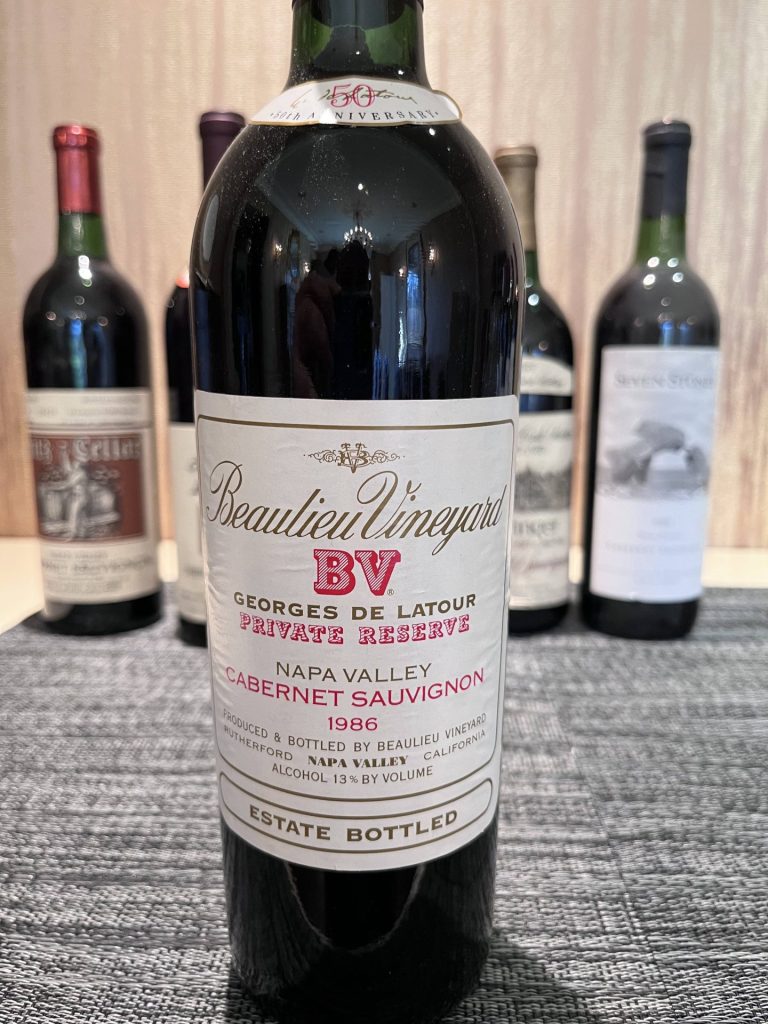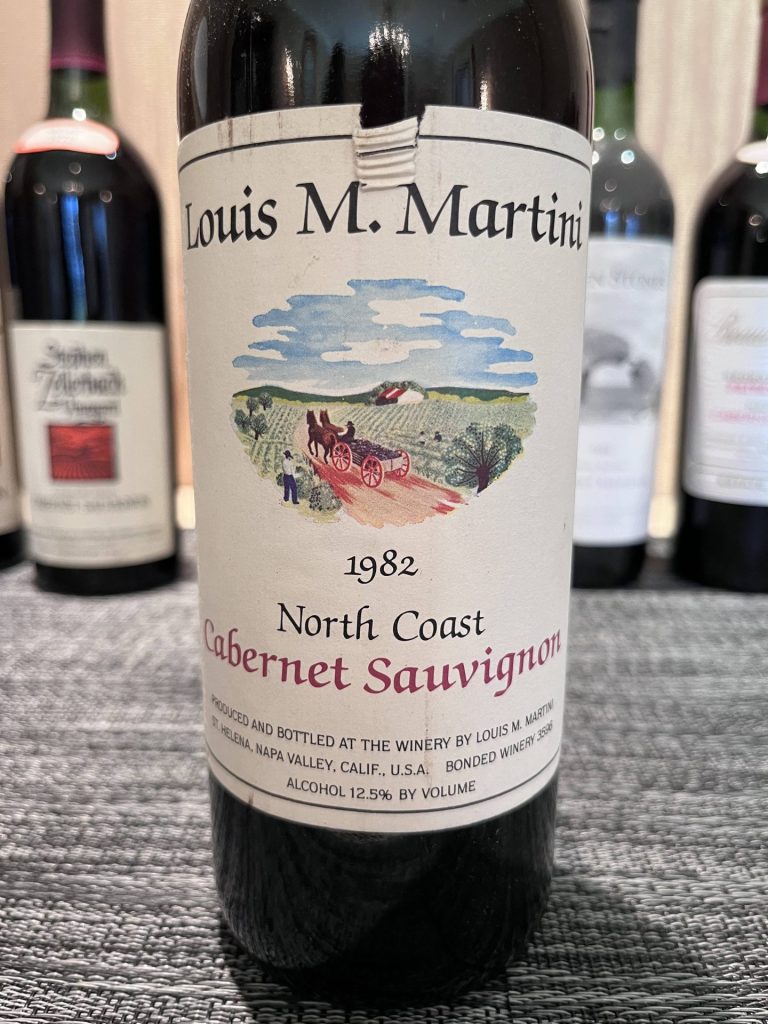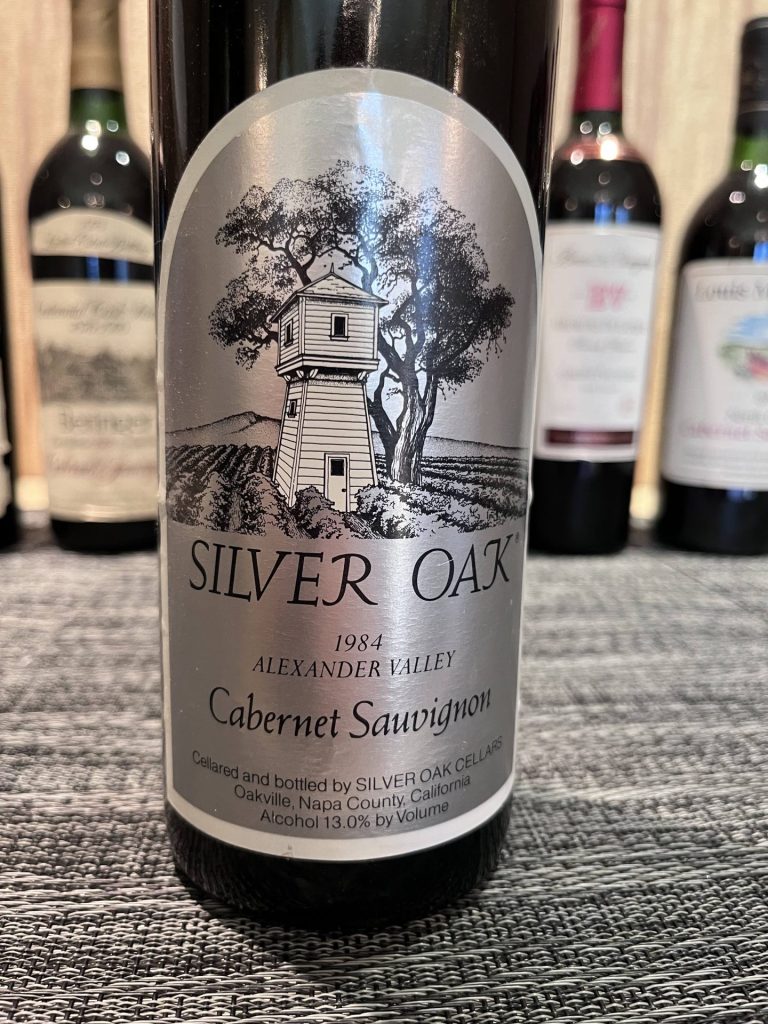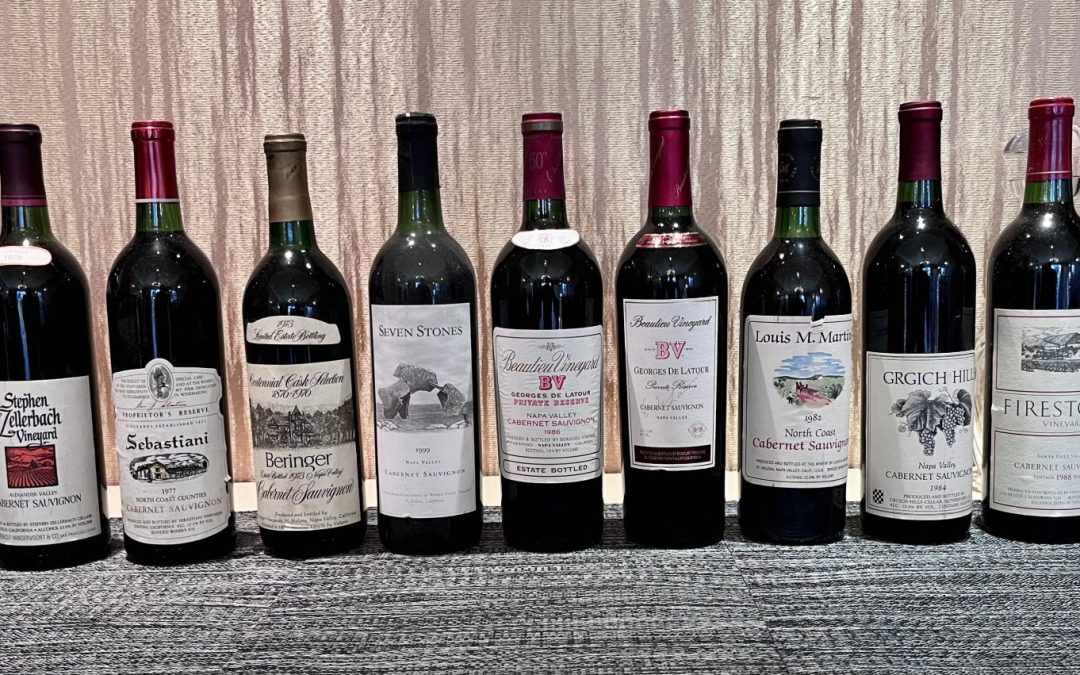
Jan 19, 2023 | California Cabernet, Sagrantino, Sebastiani, Sonoma lifestyle, Sonoma wine tasting panel, Uncategorized
The experts shock me with a surprising achievement in a crowded field of arguably the greatest of the older California Cabernets. Read the compelling story and see the results of our blind tasting:
25 – 50 year old California Cabernets (1973-1999)

Spoiler alert! Here is the end of the movie first. This photo is from the big reveal – after the tasting.
These 11 wines were carefully opened, decanted, bagged, numbered, and poured. These wines are mostly from my personal cellar from when I first became interested wine starting in my freshman year in college and up to my very first garage-made wine twelve years later.

Beringer, Cabernet, Napa Valley, Estate, ‘Centennial Cask Selection’, 1973
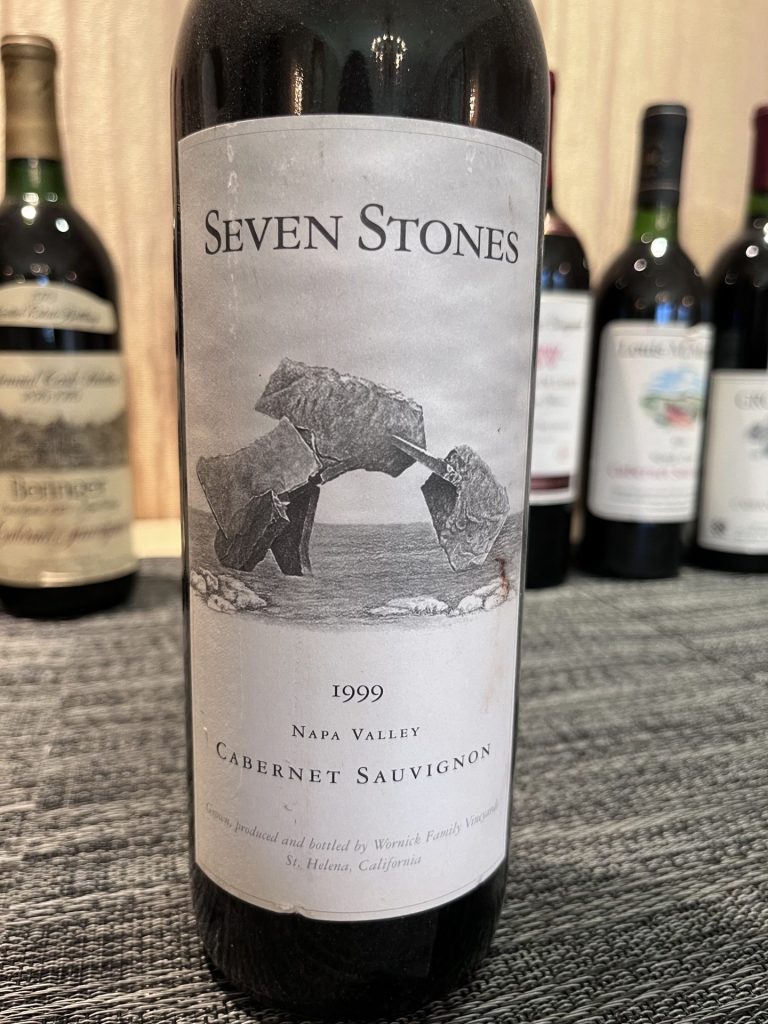
Seven Stones, Cabernet, Estate, Napa Valley, 1999 (the very first vintage, produced by me in the estate’s garage)
The results
Each taster scored their top 3 and bottom 1 wine (shown here).
The top half of this page is the individual scoring, the bottom half are the actual bottle codes. After the tasting and scoring, the list of wines was provided to the panel.
As a second thought experiment, before revealing the actual bottles, tasters attempted to match the 11 wines tasted to the printed list of 13 possible wines shown. The 2 French wines (from my father’s cellar) were not included in the tasting and were simply on the printed list as decoys – to see if anyone would take the bait. A few did.
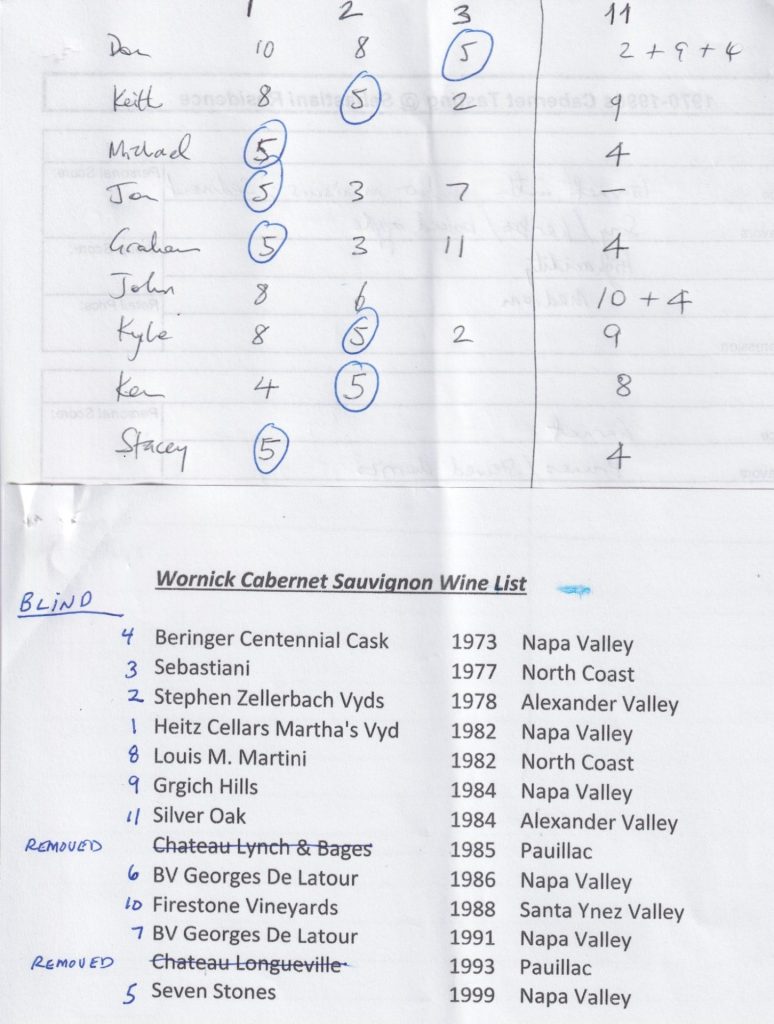
I could not believe my eyes! The clear winner? The 1999 Seven Stones! What? One of the first wines I ever produced. Not commercially either. Just made as a garage wine for our family.
Was this for real? Indeed it was.The tasting was absolutely blind. The results completely legitimate. Tabulations were scored by a very reliable accountant.
Story: The Seven Stones, Cabernet, Napa Valley, 1999 was the very first wine produced from the Seven Stones vineyard in St. Helena, Napa Valley. Planted by me in 1996 at my parent’s estate in St Helena. We were still living in Burlingame, Ca., and I had only just started my vineyard development business above Silicon Valley. That company is still operating, see this link: La Honda Winery and Post and Trellis Vineyards in Redwood City, California. The 1999 was one of the very first wines of my career – now 25 years ago. I didn’t have any formal equipment, fermented it in the garage, no drains, no press, no filter, just raw manual labor all the way through to hand bottling and labeling the 2 barrels, about 50 cases. The 1999 vintage was never sold to the public, only consumed by our family. There might be a dozen bottles still around. But the ’99 is what lead to the eventual commercialization of Seven Stones, which now garners incredibly high critic’s scores and sells out every year.
Side note: That 1999 Seven Stones was a combination of amazing grapes and some good luck. With an undergrad degree in geology, years of field work, followed by an MBA; a decade later I took a few extension courses at Davis. And interned for a few weeks during harvest at the vaunted Staglin Winery in Rutherford, Napa. The winemaker at that time was Andy Erickson, now of Screaming Eagle and Leviathan and Favia, among others. But I was the very lowest man on the totem pole and naturally spent the entire “learning experience” dragging hoses and cleaning tanks. Those are the rudimentary skills I had to apply to the 1999 vintage.
1970’s panel “Winners” and “Worst of the Best” – details on the scores (we were stunned, and if you weren’t there you might not believe it):
Best of the best:
- Seven Stones, Cabernet, Napa Valley, 1999 was the clear winner overall. I alone knew that Seven Stones was the somewhere in the lineup, but I didn’t know where? No one else had a clue that a Seven Stones wine was in the tasting until after the reveal. And as proof of the ‘blind’ results, I actually chose the group’s least favorite wine as my personal favorite (ever the contrarian, as you’ll see below). One note – to be completey fair, the 1999 Seven Stones was the youngest wine in the lineup, and perhaps therefore the ‘freshest.’
- Louis M Martini, North Coast, 1982 – with arguably the second highest scores, we all just about fell off of our chairs as this wine sold for $3.79 at the time and had a peel-off plastic capsule. But, the cork was in superb condition. It was considered a spaghetti-red table wine at the time and likely not ever intended to go up against these more expensive titans.
- Sebastiani, Cabernet, Proprietor’s Reserve, North Coast Counties, 1977 and Stephen Zellerbach Vineyard, Cabernet, Alexander Valley, 1978 were also in the running for favorite, as were several other wines vying for a place in the top 3. I was pleased for Don that his family’s wine showed so well. I was a nervous wreck knowing that our host’s family’s wine was hiding somewhere in that lineup.
Worst of Best: There really and truly were no bad wines. Not a single bottle was badly oxidized. And the ullage was excellent for all bottles:
- Beringer, Cabernet, Napa Valley, Estate, ‘Centennial Cask Selection’, 1973 – there was near unanimity in the group of this wine being the least favorite. This surprised me as I had posted it as my favorite wine. I felt it had fantastic aromas on the nose, and a depth of flavor, but others felt it was somewhat pruny and over the hill. Still available on some re-sale sites for $350.
- Grgich Hills, Cabernet, Napa Valley, 1984 – this wine garnered a few votes for least favorite. And the cork was in superb shape. So who knows? Grgich was and remains a well respected Napa winery. So many things contribute to the condition of a wine after 25-50 years. Found on some re-sale sites for $160-$300.
The Players

A pause in the action for a quick photo. At this point we’ve quietly tasted and made notes on 5 of the 11 wines. In this tasting, I invited some of my favorite colleagues from the wine world – winemakers, collectors, customers, and consultants. But I forgot to ask permission this time around, so I am afraid I cannot identity most of them.

Having a laugh: Stacey Clarke, Principal owner of Treehouse (the brand development company behind the spring 2023 launch of our Sonocaia estate Sagrantino) and me, Ken Wornick (Sonocaia, Dysfunctional Family, and Hydeout)
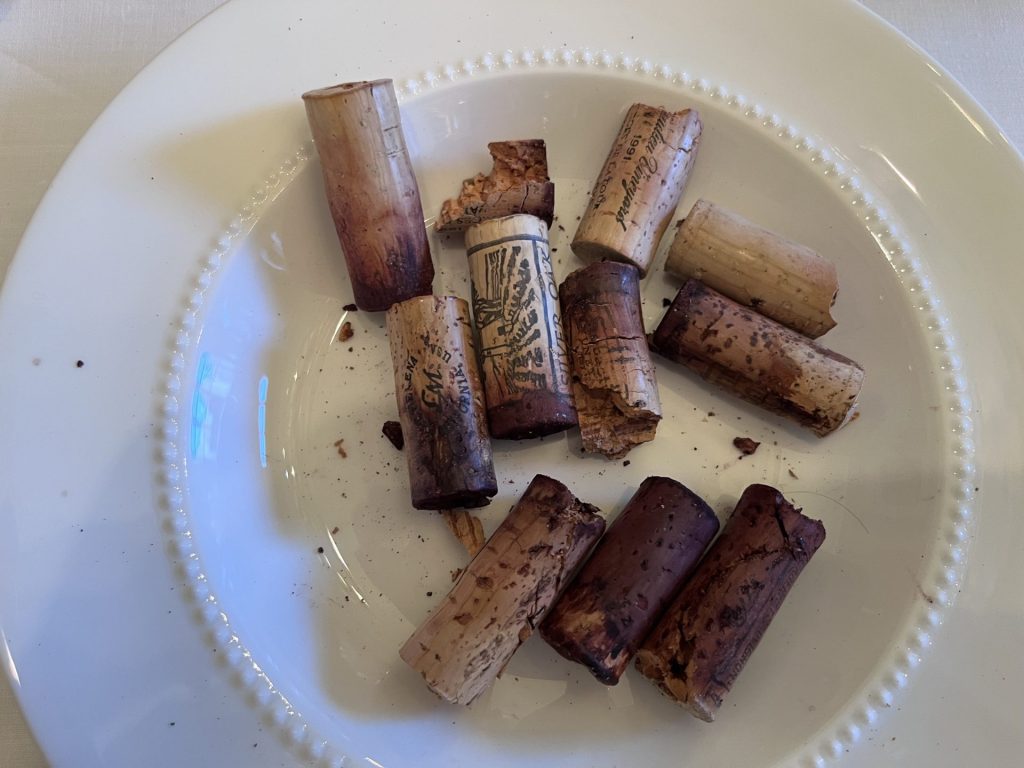
Many of the old corks were in very fine shape, likely due to the quality of the producers, and the excellent storage history, but a few disintegrated on contact and had to be very carefully extracted and wine decanted.
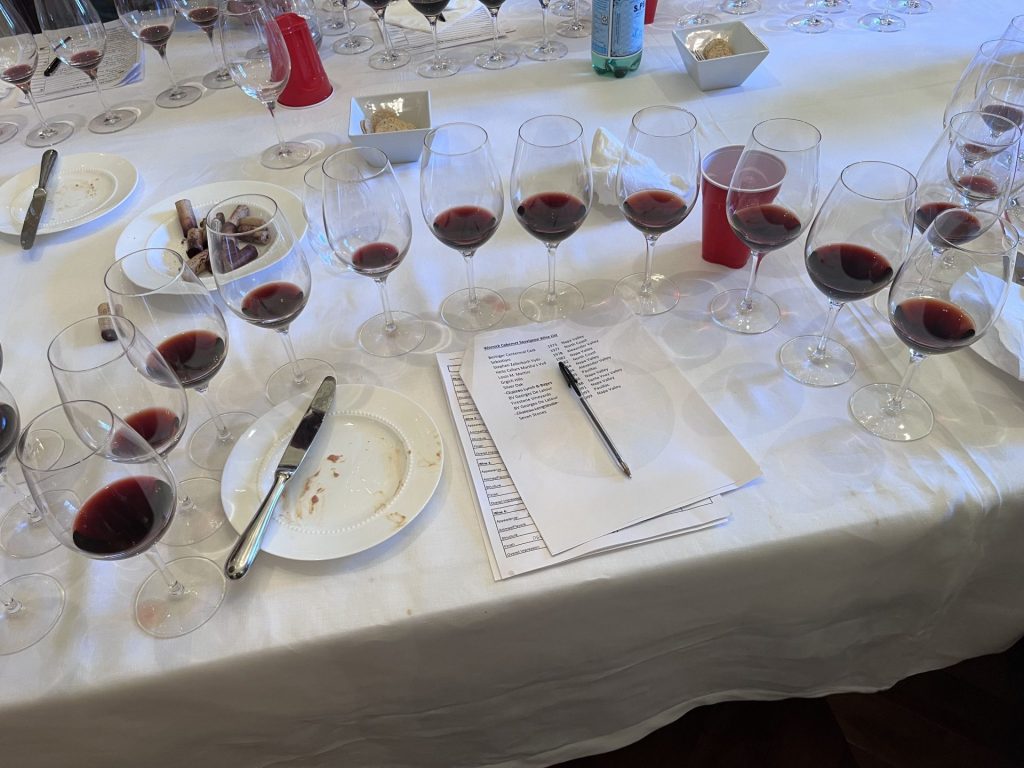
11 wines lined up and quietly tasted blind. Then tasters were supplied with a list of 13 wines, out of order, and had to guess which 11 wines were which.
Honorable mention – one of our winemaking colleagues brought a Hudson Valley Torchon Of Foie Gras (see the empty plate). It went so perfectly with our tasting. Also of note, the ducks are apparently not stuffed with feed (as with days of old). Their website says – the Moulard is a cross between the white farm duck, the Pekin, and a South American duck, the Muscovy. The Pekin has a mild flavor; the Muscovy, a gamy flavor. When the two breeds are crossed, they produce a high quality, deliciously unique flavor sought after by the finest chefs worldwide. Moulard ducks have a special ability to store fat in the liver. Like the Muscovy, they are ground-foraging ducks. Moulards don’t fly and are not fans of open water. These characteristics make the Moulard the ideal breed for producing foie gras.. The website says: Don’t Sweat the technique! The Torchon of Foie Gras is the ultimate cold preparation. Translating to “Towel” in French, its name is a result of the preparation method where the Foie Gras was traditionally tied in a kitchen towel, rolled, poached, and hung to chill for several days. The torchon of Foie Gras is a labor of love that we have refined for your convenience and enjoyment. Its cylindrical shape makes for an easy and impressive slice & serve that is guaranteed to delight.
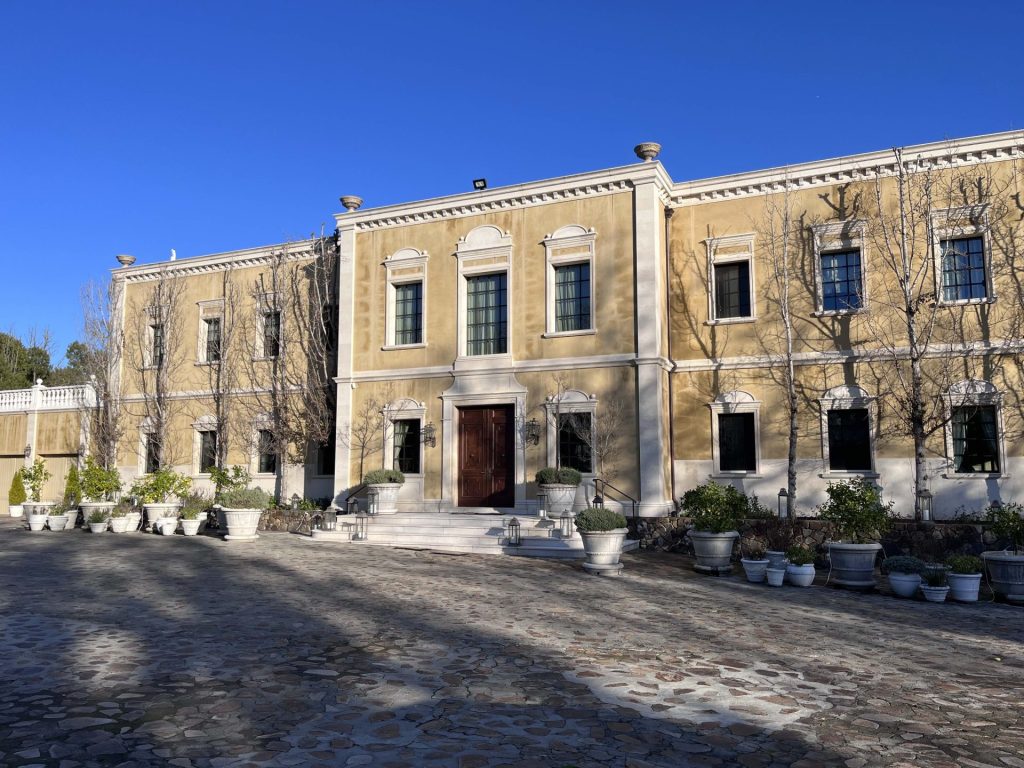
The scene of the crime, the home of our very gracious host, Don Sebastiani Sr. of Sonoma. My thanks as always to Keith Casale, CFO of Landers Curry, who assisted Don (and me) in organizing this tasting.
Chicken Murder, Bobcat style

Went for the usual collection of chicken eggs at dusk, found this sad scene of feathers but no chicken – one of the most productive and peaceful of our flock – a Buff Orpington chickens was killed. Looks like it was pulled through a hole in the fence and dispatched just outside the coop door. This might be the first time a bobcat has taken a chicken. For us, it’s usually the hawks.
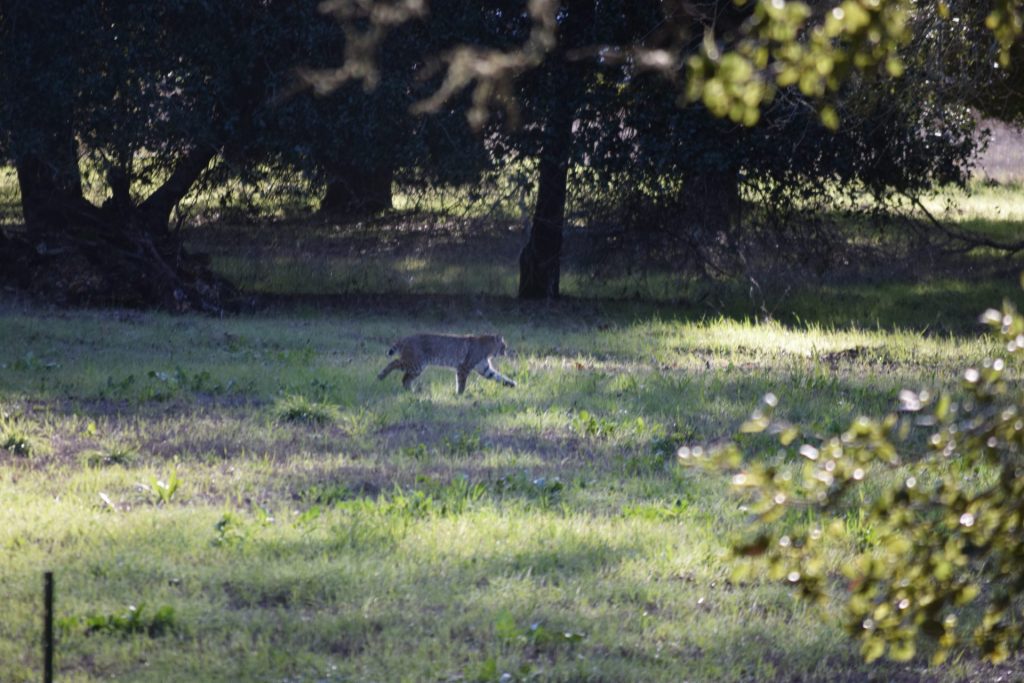
The likely fugitive from justice, a really gorgeous Bobcat crossing from the chicken coop to the vineyard. Note the telltale striping on the front left leg.
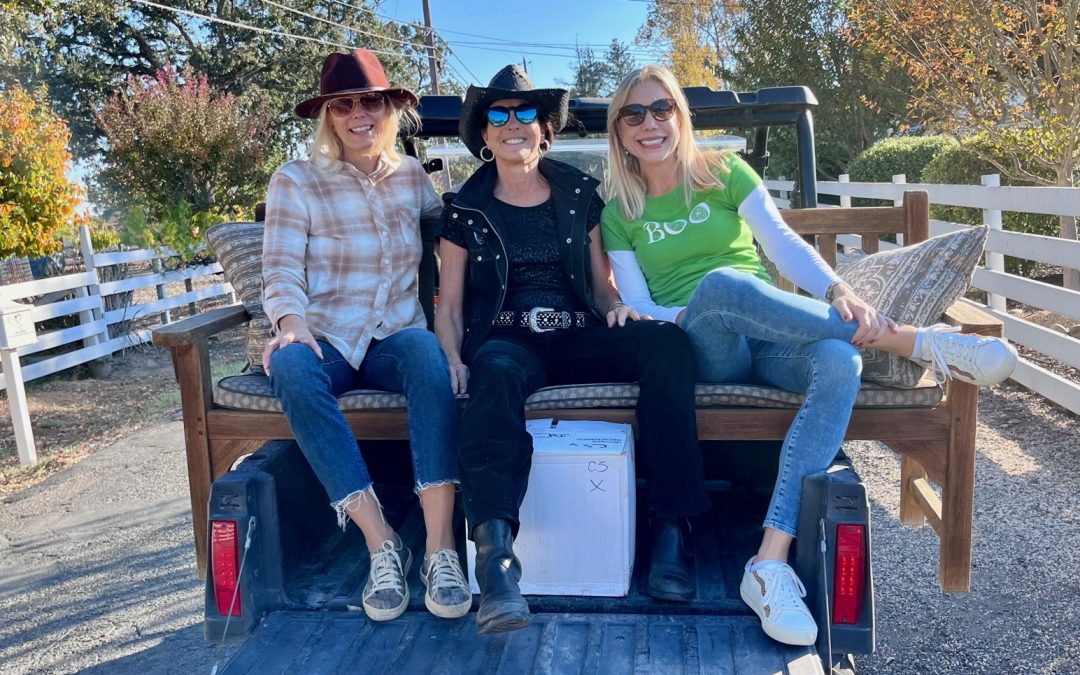
Nov 30, 2022 | Sonoma lifestyle, agave, Hydeout Sonoma, Sagrantino, Sonoma, Sonoma Farming, Sonoma harvest 2022, Sonoma Valley, tequila, things to do in Sonoma
What happens in Sonoma when the harvest is done?
The very last tank of grapes has finished fermenting. The tank is drained of wine and placed in barrels (that liquid is called the “free run”). Then the remaining fermented grapes in the tank are moved into the press and gently squeezed (and the result is called the “press fraction”). And what’s removed from the press after pressing (called the “pomace”) is either sold as animal feed or recycled into green waste or sent to our distiller and turned into Grappa, Brandy, and Cognac; and the seeds are further pressed into grapeseed oil. And that really marks the end of the harvest season.

This is what 2 tons of dense Syrah grape pomace looks like when it comes out of the press. It’s dark purple and bone dry. The very last cuveé of wine has been barreled.
There still remain some chores to manage over the winter: the newly filled wine barrels will be carefully monitored as the secondary Malo-Lactic fermentation is monitored and managed (and where the tart Malic acid, think green apple, is slowly fermented into Lactic acid, with potential health benefits including improved gut health, immune system support, and antioxidant effects). Barrels must be topped off due to evaporation. And as the wine settles we need to taste every wine to assure things are coming along to our liking. And, we start thinking about which of the older wines need to be prepared for bottling this spring. Last, now is the time for the winery to be thoroughly cleaned from top to bottom. And only then will it be time for everyone to have a much needed rest.
A brief note about the 2022 season: It started off with a really hard freeze right as many grape varieties were just budding out. There was some damage to some vineyards resulting in crop loss as much as 50%. Then after a normal but very dry summer, the record heat wave struck, 5 days over 100F and 5 nights in the 80F’s putting extreme stress on ripening fruit. And then adding insult to injury, 2 inches of rain. It was one of the most confounding and complicated growing seasons ever. More on that when the 2022’s are ready for release in 2024.
Halloween
Halloween is usually the first sign that the wonderful long slog that is harvest and winemaking is about to wrap up. When bright orange pumpkins start appearing all over town, we know the harvest season is almost over.
Chickens
As the cold weather settles in at the Hydeout, the chicken egg production starts to fall off as the chickens shift their energy from egg production to winter feather production. And in our case, they also start flying the coop and hiding their eggs in hilarious hard-to-find places.
Final garden harvest
As is the tradition in the Fall, it’s time to harvest the last of the garden produce, clean it up, and pickle it all in bell jars.
Wood slab table – restarting an old project
In 2020, St Helena in Napa Valley was surrounded by the Glass fire. Acres of gorgeous oak forest was lost. With help from friends, I located and set aside one of the fallen oaks and had one of the fire department crews mill it into oak slabs for me. The new table from this project will go into the new winery barn here at the Hydeout.

Two oak slabs, about 10 feet long and 18 inches wide, will be joined along the inside edges to form a new table. The outer live-edges still show the burn scars from the fire. It is a stark reminder of how the fires damaged lives and property.
Margaritas
By the time of the Thanksgiving holiday in late November, winemaking has truly concluded, and our Prickly Pear Cactus flowers are ripe. And that means it’s time for the whole family to get involved in producing our Prickly Pear Agave Nectar. And our tart, sweet, smoky, mezcal Margaritas!
Recipe: Click here!
Living art at the Hydeout
Dear friend, character, bon vivant, and Sonoma artist Jock McDonald, with assistance from his wife Sherry McDowell, set up a photo shoot for a new project Jock is developing called “TRASH.” I can’t say any more at this time as the final form of this new work is on its way to Art Basel in Miami, Florida right now! These are preliminary images only and in no way depict the final art form that Jock has developed. To learn more, click here.
FAMILY
This is the time of year we all gather as family and enjoy another wonderful year of life, trials, tribulations, health and happiness. Here is the entire Hydeout team:

Happy holidays from the entire Wornick family – Ken, Dennis, Sophia, Cynthia, Harry, with Elyse, Jessica, and Tony the dog

Oct 15, 2022 | Sagrantino, Dysfunctional Family Winery, Hydeout Sonoma, Sebastiani, Sonoma harvest 2022, Sonoma Valley
Setting up for a blind tasting of Sagrantino
Wine is to be enjoyed. Everyone gets to decide exactly what they like. Wine labels, the setting, the food, the mood; everything influences how we feel about a particular wine.
A genuinely blind tasting is the closest we can get to objectively measure one wine against another. And even then, the order of favorites can change – if the tasting is done before lunch or at dinner time, on weeknights or weekends, even the mood of the group, or just one small whispered remark, can re-order the evaluation and the results. Still, it is educational to taste wines blind, as we did here with these Sagrantino wines:
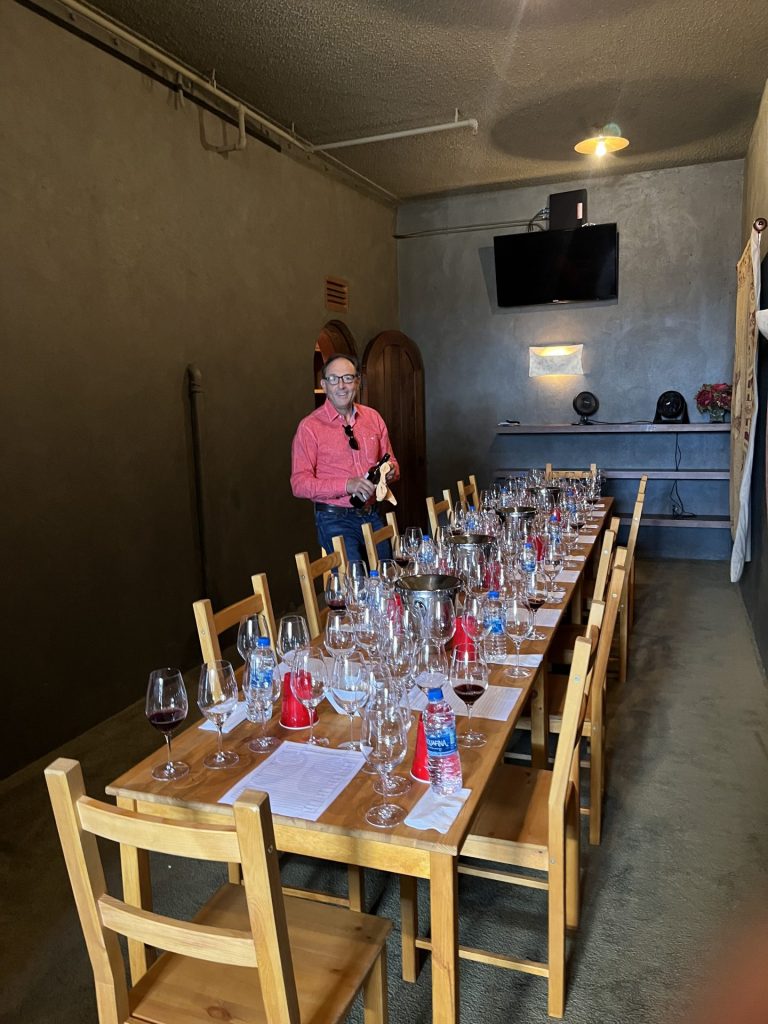
In this windowless cave under a spectacular private estate in Sonoma, we set up a blind tasting of Sagrantino wines.

The wines were bagged and numbered for complete anonymity.

Then, to assure strict adherence, all of the wines are poured in careful numbered order into wine glasses in advance, before the tasting panel entered the room
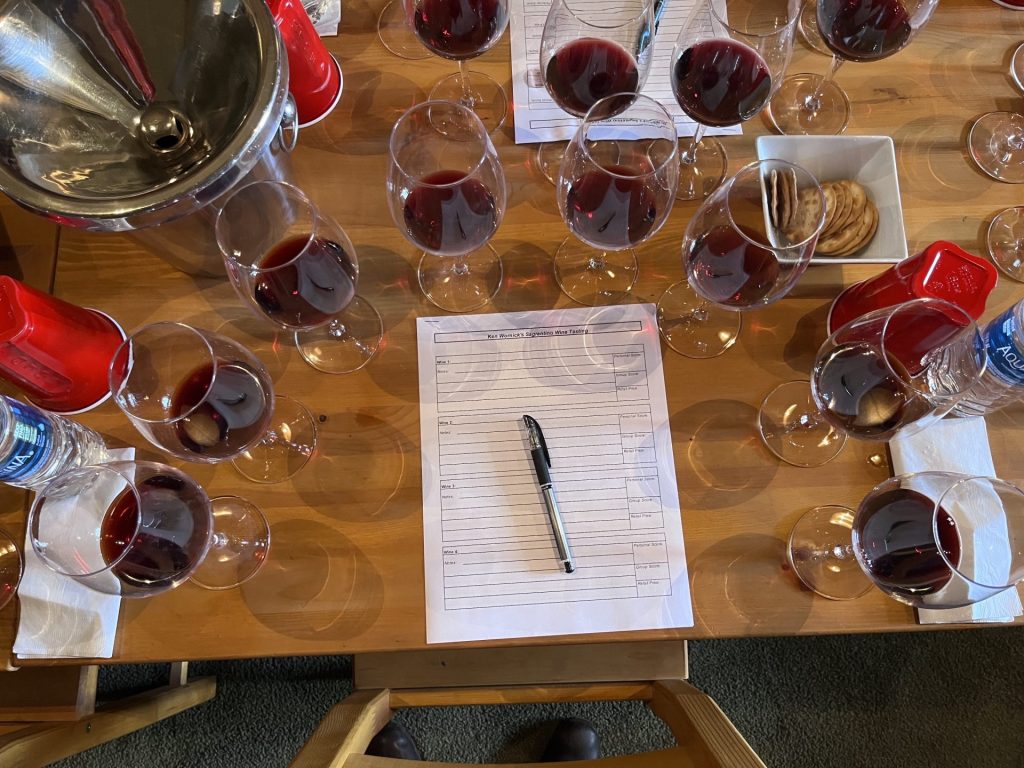
The panel was seated. And the hard work began. We tasted the wines one by one, making scrupulous notes along the way. It takes concentration and focus to really evaluate each wine carefully. The wines were judged on the basis of color, aroma, viscosity and mouthfeel, tannin structure, and finish.

The participants: When we were done tasting and making notes, the data was collected and tallied and force-ranked. Then, we revealed all the wines and had a free-wheeling discussion over the results. The professionals were quick, efficient, and showed great certainty.
From left to right, clockwise:
- Liz Thatch, Master of Wine and Distinguished Professor of Wine – click: Liz Thatch
- Graham Smith, CEO and wine collector – click: Graham Smith
- Anne Mieling, French-born wine expert – click: Anne Mieling
- Ingrid Reyes, CEO, M&A Creative Agency – click: Ingrid Reyes on LinkedIn
- Jennifer Arie, Director of Customer Success, Comm7 eCommerce platform – click: https://commerce7.com/about/
- Ken Wornick, winemaker, Sonocaia Sagrantino and Dysfunctional Family Winery – click: https://www.sonocaia.com
- Don Sebastiani, Sr., our host – click: http://donsebastianiandsons.com
- Steve Bush, former bio-med devices CEO, restauranteur, wine collector – click: Steve Bush
- Jon Curry, owner of Landers Curry, former board chair of Sonoma’s Int’l Film Festival – click: https://www.landerscurry.com/home
- Kelly Nice, CEO/Founder, Nice and Co. Ad Agency – click: https://www.niceandcompany.com
- Keith Casale, local Sonoma CFO – click: Keith Casale
- Cynthia Wornick, Dir. of Marketing, Sonocaia and DysfunctionalFamily Winery – click: Cynthia Wornick
Note: our host for this event was Don Sebastiani, Sr. (#7 above). A true gentleman, host extraordinaire, smoker of fine cigars, lover of fine wine and food, fluent speaker of at least five languages, a true Sonoma native, and so modest you’d never know any of this about Don unless someone else told you.
A total of eight wines were evaluated – seven pure Sagrantinos from Umbria, Italy, and our 2020 Sonocaia (just-bottled estate reserve Sagrantino from Dysfunctional Family Winery at the Hydeout Ranch here in Sonoma).
Wines revealed – here are the 8 wines revealed after the blind tasting:
I was floored that our inaugural, very young, and not-yet-released 2020 Sonocaia Estate Reserve Sagrantino earned a strong third place, especially against these world-renowned Umbrian all-stars.
First through third place were tightly bunched, the next wine was a very distant fourth.
- Arnoldo Caprai 2003 Collepiano Sagrantino di Montefalco (99 pts)
- Arnold Caprai, 2016 Montefalco Sagrantino, 25th anniversary edition (97 pts)
- Sonocaia, 2020, Sonoma Valley, Sagrantino, Estate Reserve (94 pts)
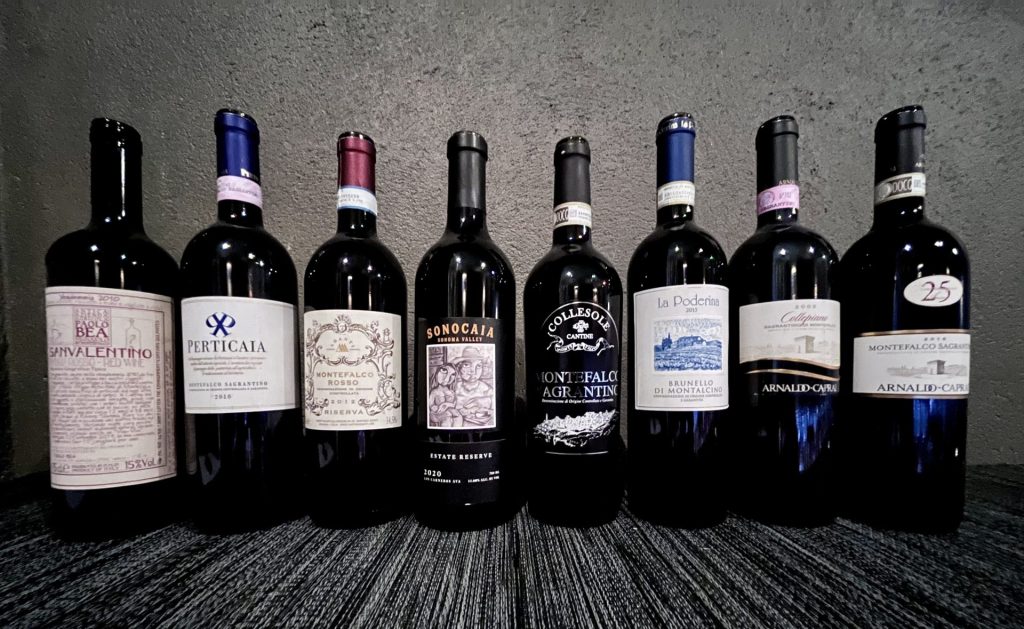
The full lineup of Sagrantino wines – seven from Umbria and one from Sonoma

After the tasting, the panel retired outdoors to the patio for discussion and a perfectly curated lunch hosted by Don Sebastiani Sr. and prepared and served by renowned Chef David Bush from Oso Restaurant in downtown Sonoma. If you have not yet visited OSO, please do; it is a wonderful, locally-operated delicious family-owned restaurant.

Chef David Bush has a storied track record of amazing stops on the culinary trail, but certainly his restaurant Oso in downtown Sonoma is his crowning jewel, so far! Find it here: OSO Restaurant in Sonoma
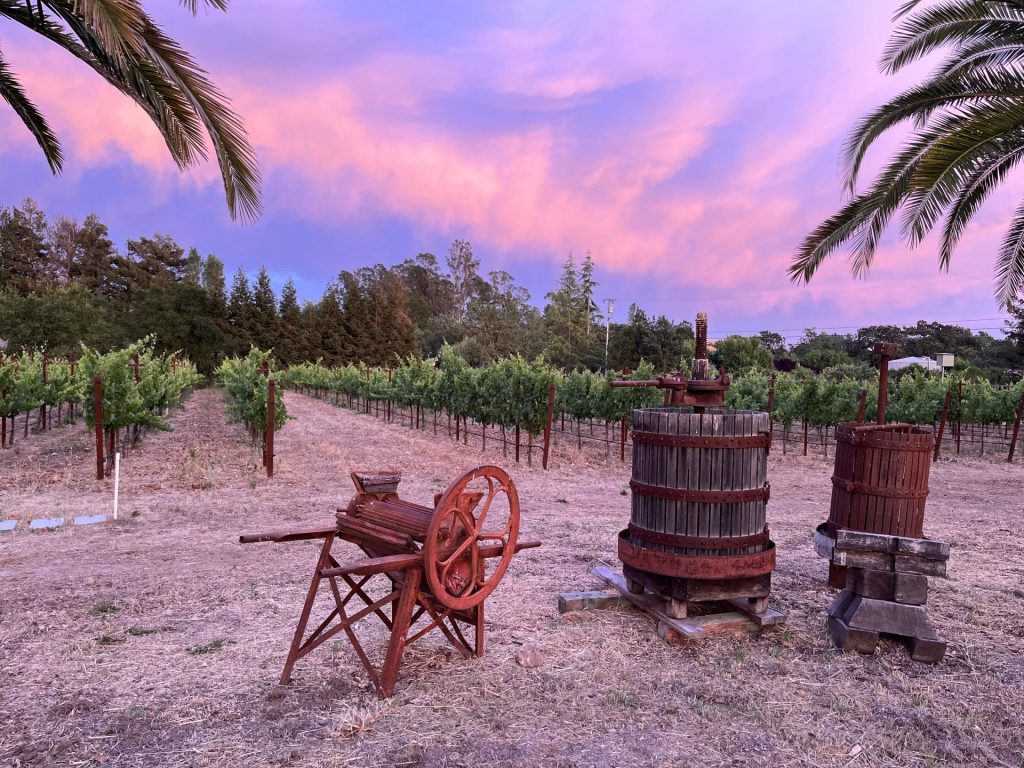
The “Sonocaia” estate Sagrantino vineyard during a particularly lovely sunset in early September. Harvest is not expected until mid-October.
But wait, there’s more, another blind wine tasting event: Hydeout Consulting client “Quail Run 2020 Estate Cabernet”, just bottled, competes with older Cabernet wine country legends and comes out a winner!
We are the consulting winemakers for the Quail Run estate Cabernet. Just a couple of weeks ago, we delivered the 2020 vintage to the client. The wine was bottled after 23 months of oak aging. The client organized an inaugural blind tasting and invited a knowledgeable group of friends and neighbors to participate. I admit I was a bit nervous knowing this newly bottled inaugural vintage (and possibly my career) was about to go head-to-head against some of the finest Cabernet’s in my client’s formidable wine cellar!
Quail Run 2020 was tasted against Stone Edge Farm 2014, Repris 2018, and Stag’s Leap 2019…
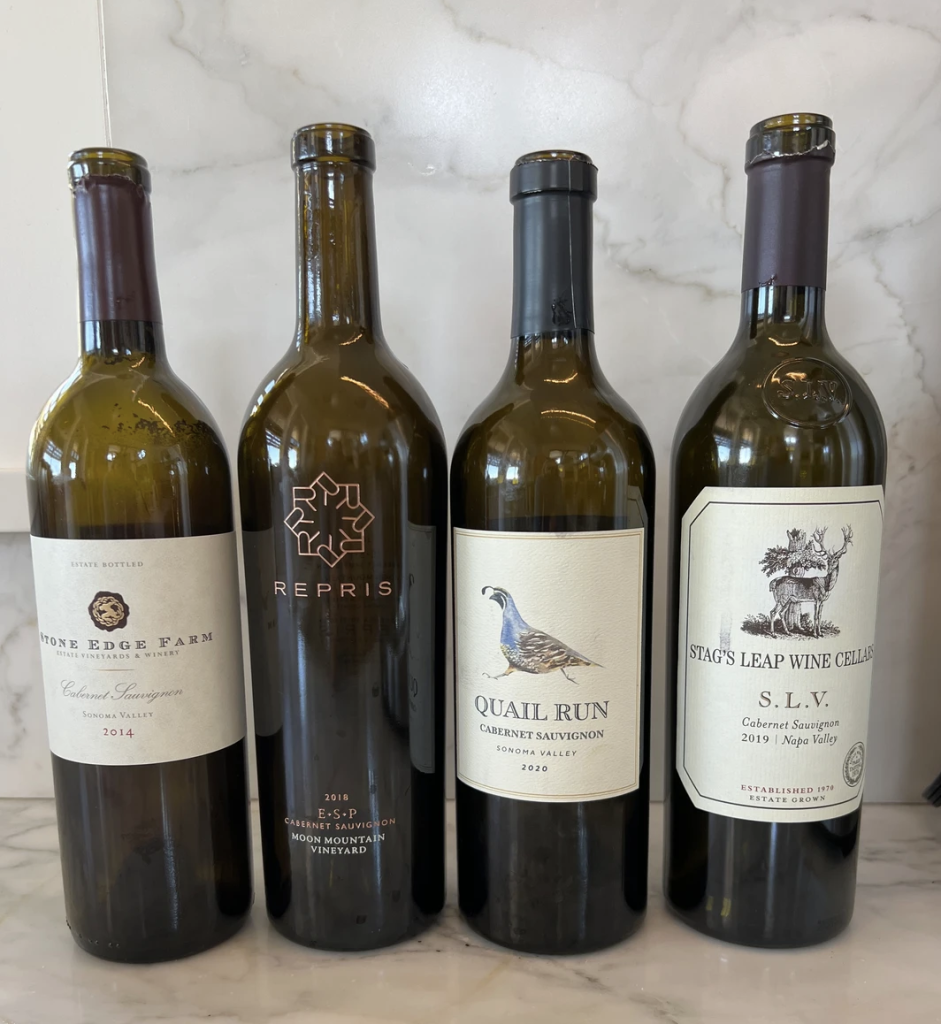
The contestants in this blind wine tasting event.

At the winery, Quail Run estate Cabernet clients Jan and Patrick (right) tasting their developing 2020 estate Cabernet in August 2022 just prior to bottling.

And fresh off the bottling line, the Quail Run estate Cabernet, Sonoma Valley.
A good friend of the client, Austin Texas expert wine educator Jim Bushee, wrote a blog post about the Quail Run blind tasting. To see the results, read here: Click here to read Jim Bushee’s blog post
The client also wrote a blog post about her version of the tasting: Quail Run estate Cabernet blind tasting blog post
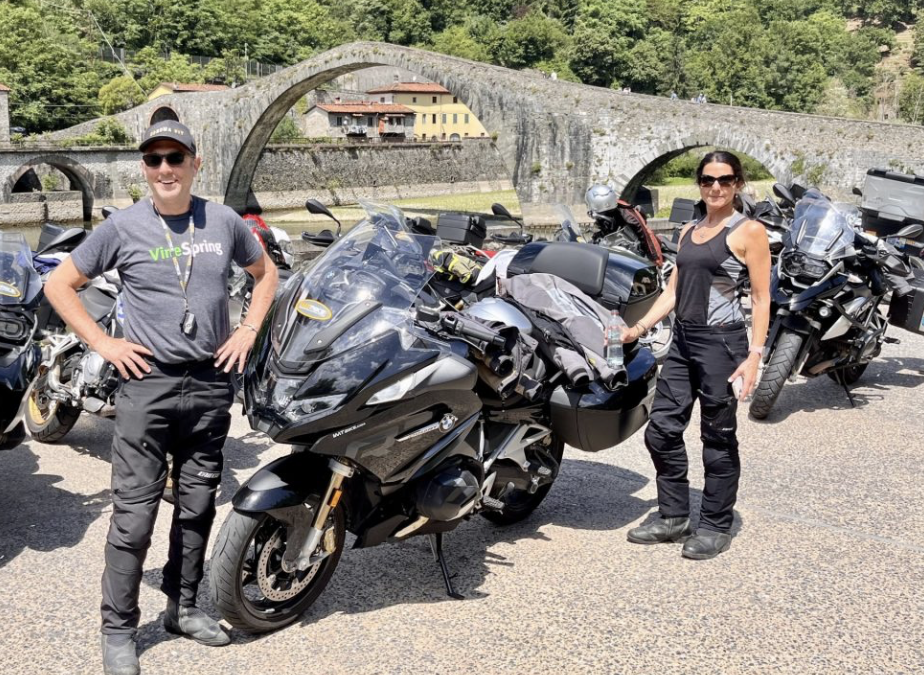
Oct 1, 2022 | wine and motorcycles, pandemic, Sagrantino, Sonoma lifestyle
When late summer arrives, things get very busy in the wine business. There are endless last minute farming chores, the final blending of wines, emptying barrels and bottling (to make room for the coming vintage), and of course the impending harvest and winemaking.
Umbria and Sagrantino
Prior to all of that, and after the main thrust of Covid briefly waned in Europe, we were finally able to schedule our long-planned trip to Italy, specifically Umbria, to survey the latest in the world of Sagrantino – the deep dark inky Italian grape that we have been growing here at the Hydeout ranch. We are obsessed with Sagrantino and are one of very few growers in the United States.
Sagrantino – see this article: The next ‘power red,’ poised for a breakout in the wine world
As an enthusiastic producer of Sagrantino here in Sonoma, the Umbrians received us like royalty at every stop:

After a few days in Rome to adjust to the jet lag, we headed into our Umbrian itinerary. First stop was the Chiesa Del Carmine where we met the executives and winemakers and tasted many Sagrantino blends from barrel and bottle. The Chiesa is in a rather remote location set in a small private valley, very much a sanctuary just like the old church from where it takes its name.

Of course, at every stop, the food and wine was spectacular. Here inside the converted church winery, Cynthia is starting in on another of many food and wine tastings. It did not take long to confirm that Umbrians feel strongly about their Sagrantino history.
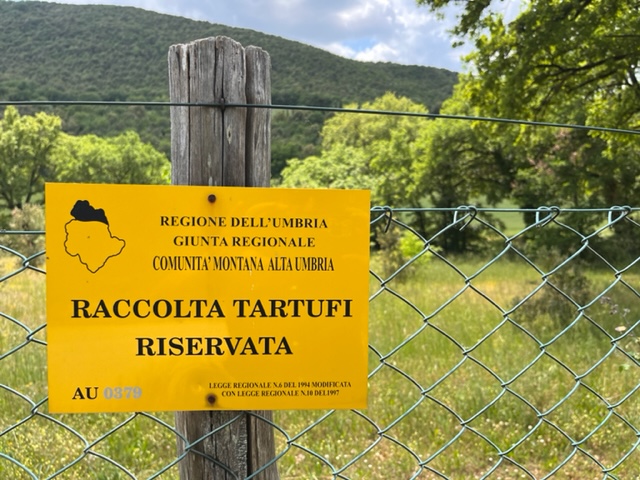
Truffles are nearly a staple in Umbria. This truffle preserve in Montana Alta Umbria was purposely planted with Oak, Hazelnut, Beech, Chestnut, and then fenced from marauding animals (and people) and which yields a surprising quantity and quality of earthy leathery gems, generally harvested from December through April.
Naturally, the food scene in Umbria is not to be believed. The Umbrians are quite serious and proud of their food and wine.

Yet another very warm welcome as part of the “Sagrantino tribe”, one of the expected highlights of the trip through Umbria at perhaps the first and most well-reputed maker of Sagrantino, Arnaldo Caprai Winery, as they celebrate their 25th anniversary (Cinquant’ Anni).

Our hosts at Caprai pulled out all the stops opening every imaginable bottle, from pure 100% Sagrantino to various blends and white wines, including the 25th anniversary bottling (left), all different in style and all compelling and delicious.
Sonocaia (So-No-Kī-Yah), 2020 Estate Reserve Sagrantino

Our newest brand, Sonocaia (pronounced So-No-Kī-Yah)
We’ve been living and breathing and talking about Sagrantino long before we even planted it at the Hydeout ranch here in Sonoma. Above, the inaugural 2020 bottling of our new brand, Sonocaia. Pronounced So-No-Kī-Yah, we won’t be offering this wine for sale for a few years. Some bottle age is required.

Inaugural 2020 Sonocaia and some of the other Dysfunctional Family wines in the lineup
Sonocaia is our new Estate Reserve 100% Sagrantino brand name. Dysfunctional Family Winery remains our other brand. We released two Sagrantino-based wines, the 2018 and 2019, on our website, under the Dysfunctional Family Winery brand. These two wines contain some Sagrantino but when the vineyard was younger. 2020 is the first full-strength Sagrantino vintage. A blind tasting of Sonocaia up against several noteworthy Umbrian Sagrantino’s was recently conducted. Watch for the results in the next blog post. To shop our wines now or to learn more, click here.
Touring the Mediterranean by motorcycle
We never miss a chance to squeeze motorcycle touring into a vacation. After Umbria and the enchanting world of Sagrantino, we flew to Barcelona, picked up our rented BMW R1200RT sport touring bike, loaded our gear, and headed for a cruise around the Mediterranean. Our route took us from Barcelona Spain, through Andorra, into southern France, and on into Tuscany, and eventually back to Rome.

Here we are climbing into the mountains not far from Andorra, a landlocked country inside northern Spain
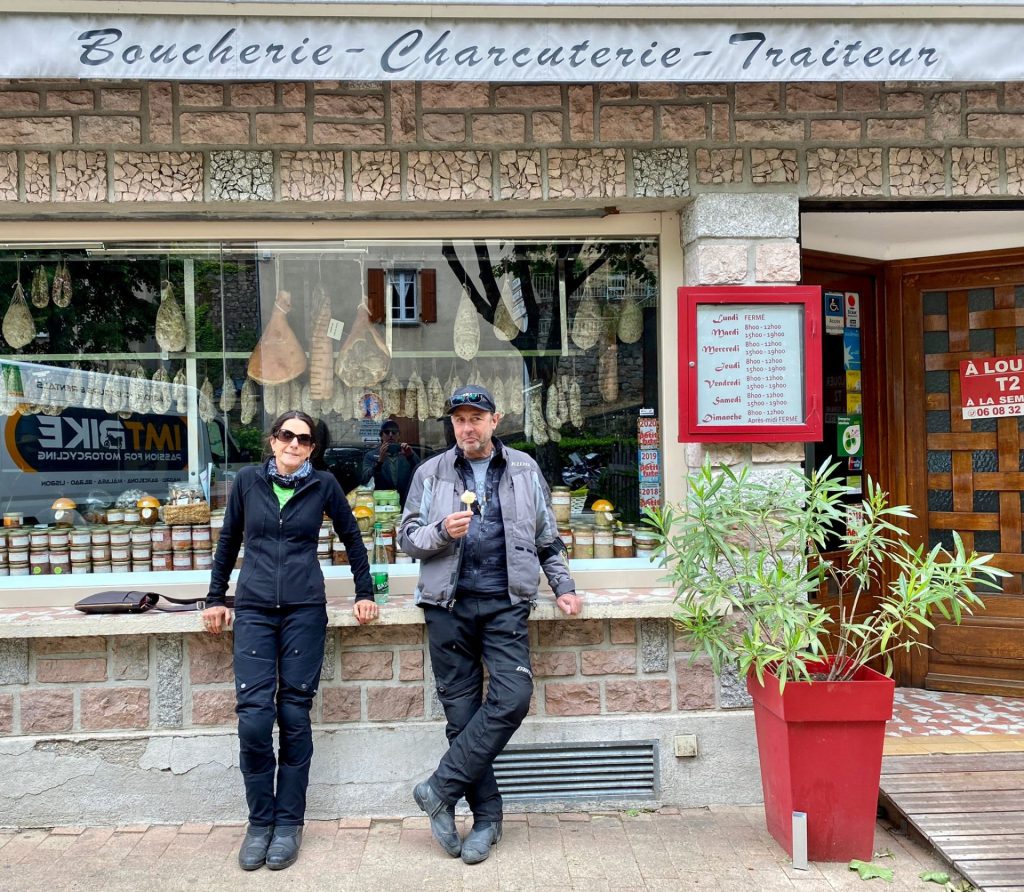
No day drinking, ever, for this motorcycle pilot, so I have to rely upon other treats – like ice cream. Cynthia has no such restrictions as a passenger and, as is the local tradition, enjoyed wine with almost every lunch. But for sure we both enjoyed endless mountains of baguettes, olive oil, cheese, and Cassoulet. And wine with dinner! Here we are in Cap D’Antibe in southern France where everything closes promptly (and with no debate) for the afternoon.

The Serchio River, in northern Tuscany, province of Lucca, as it passes under the “Devil’s Bridge” (Pont De la Madeleine). On this day, the key feature was the temperature, almost 100F inside our helmets.

Our United Airlines pilot somehow noticed our enthusiasm and invited us onto the 777 flight deck for a look around. You can see who he put into his pilot’s seat. Yeh. It was a fantastic trip in every way. And we arrived home rested and ready for another harvest season. This will be my 23rd vintage.







